Night sky, April 2024: What you can see tonight [maps]
Find out what's up in your night sky during April 2024 and how to see it in this Space.com stargazing guide.
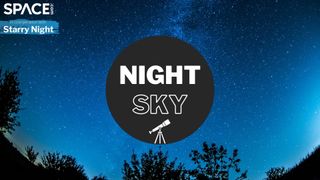

Looking for a telescope for the next night sky event? We recommend the Celestron Astro Fi 102 as the top pick in our best beginner's telescope guide.
The night sky tonight and on any clear night offers an ever-changing display of fascinating objects you can see, from stars and constellations to bright planets, the moon, and sometimes special events like meteor showers.
Observing the night sky can be done with no special equipment, although a sky map can be very useful, and a good telescope or binoculars will enhance some experiences and bring some otherwise invisible objects into view. You can also use astronomy accessories to make your observing easier, and use our Satellite Tracker page powered by N2YO.comto find out when and how to see the International Space Station and other satellites. We also have a helpful guide on how you can see and track a Starlink satellite train.
You can also capture the night sky by using any of the best cameras for astrophotography, along with a selection of the best lenses for astrophotography.
Read on to find out what's up in the night sky tonight (planets visible now, moon phases, observing highlights this month) plus other resources (skywatching terms, night sky observing tips and further reading)
Related: The brightest planets in April's night sky: How to see them (and when)
Monthly skywatching information is provided to Space.com by Chris Vaughan of Starry Night Education, the leader in space science curriculum solutions. Follow Starry Night on Twitter @StarryNightEdu and Chris at @Astrogeoguy
Editor's note: If you have an amazing skywatching photo and would like to share them with Space.com's readers, send your photo(s), comments, and your name and location to spacephotos@space.com.
Calendar of observing highlights
Monday, April 1 - Third Quarter Moon (at 03:15 GMT)
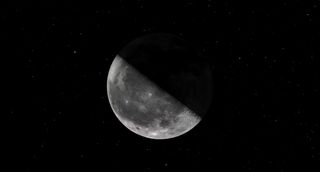
The moon will reach its third quarter phase on Monday, April 1 at 11:15 p.m. EDT or 8:15 p.m. PDT, which converts to 03:15 GMT on April 2. Third quarter moons rise around midnight in your local time zone, and then linger in the southern sky after sunrise. At third, or last, quarter the moon is illuminated on its western side, towards the pre-dawn sun. The week of dark, moonless evening skies that follow this phase will be ideal for observing deep sky targets in binoculars and telescopes, especially spring galaxies.
Monday, April 1 - Comet Pons-Brooks in Evening (after dusk)
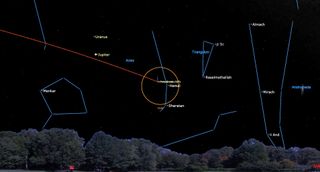
When the periodic comet 12P/Pons-Brooks passes the sun at perihelion on April 21, it should become bright enough to see with unaided eyes and definitely with binoculars. But For observers at mid-northern latitudes, the comet will be low in the western twilight after sunset and difficult to see at that time. Instead, take the opportunity to see this once-every-71-years comet in a dark, moonless sky during evening this week as it travels right to left (or celestial southeast) from Aries’ bright star Hamal toward Jupiter (red path). Use binoculars (orange circle) to sweep the sky between them and look for a faint fuzzy patch. The fainter tail will extend upwards. A telescope or a long exposure photo should show the coma’s greenish hue. The comet will set by about 9:45 p.m. local time, so start looking as soon as the sky darkens.
Tuesday, April 2 - The Whirlpool and Pinwheel Galaxies (all night)
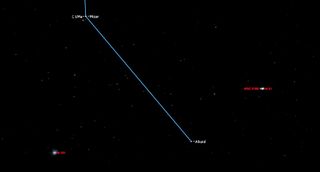
In the evening during early April, the Big Dipper is positioned high in the northeast with its handle pointed down. Under dark sky conditions two impressive galaxies can be seen in binoculars and backyard telescopes by using the bright star Alkaid at the tip of the dipper’s handle to find them. The Pinwheel Galaxy, or Messier 101, is a spectacular, large, face-on spiral galaxy positioned a slim palm’s width to the lower left (or 5.5 degrees north) of Alkaid, forming an equilateral triangle with Mizar, the double star at the bend of the dipper’s handle. This relatively close galaxy (21 million light-years away) is nearly as large as the full moon in the sky. Since the galaxy’s light is spread over such a large area, its overall brightness is lowered. Aim your binoculars several finger widths to the upper right (or 3.7 degrees to the southwest) of Alkaid to discover the iconic Whirlpool Galaxy, aka Messier 51. This spiral galaxy’s angular size is smaller, but it will look somewhat brighter in your binoculars and telescope. A secondary galaxy core designated NGC 5195 close beside M51 is linked by a bridge of material.
Thursday, April 4 - Asteroid Pallas Changes Course (overnight)

On Thursday, April 4, the main belt asteroid designated (2) Pallas will cease its eastward motion through the stars of southern Hercules and commence a westerly retrograde loop that will last until July. Tonight, the magnitude 9.2 minor planet will rise in late evening and remain visible all night long in a backyard telescope (orange circle), positioned between Hercules’ medium-bright stars Kornephoros (Beta Herculis) and Rasalgethi (Alpha Herculis). For the rest of April Pallas will travel left and upwards (dotted path) towards another Hercules star named Zeta Herculis. Pallas will reach peak visibility on June 19.
Friday, April 5 - Old Moon Approaches Planets (before sunrise)
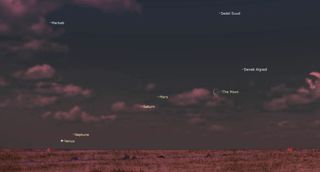
The old waning moon’s pretty crescent will shine above the southeastern horizon on Friday morning, April 5. Before the sky brightens too much, sharp-eyed observers with an unobstructed view can see the planets Mars and Saturn arrayed a generous fist’s diameter to the moon’s left (or celestial east-northeast). The two planets will appear about the same brightness and cosy enough to share the view in binoculars (orange circle). Much brighter Venus will rise to their lower left around 6 a.m. local time, but faint Neptune near it won’t be visible. Observers in westerly time zones will see the moon a bit closer to the planets. Be sure to turn all optics away from the east before the sun rises.
Saturday, April 6 - Crescent Moon near Mars and Saturn (before sunrise)

The old moon’s visit with the morning planets will continue on Saturday, April 6. After 24 hours of motion, the moon will shine directly below Saturn, with Mars positioned at their upper right. Once the moon rises around 5:30 a.m. local time, all three objects will fit within binoculars’ field of view - but turn all optics away before the sun rises. Observers in most of Antarctica, the Kerguelen Islands, and Marion Island can see the moon occult Saturn around 09:30 GMT.
Sunday, April 7 - Sliver of Moon near Venus and Neptune (before sunrise)

Before sunrise on Sunday, April 7, skywatchers located along tropical latitudes can try to see the extremely thin crescent of the old moon poised two finger widths to the upper right (or celestial southwest) of the bright planet Venus. Look just above the eastern horizon as the sky is brightening. The very faint planet Neptune will be located about the same distance to the moon’s upper right. The trio will be cosy enough to share the view in binoculars (orange circle), but the dawn twilight will make seeing Neptune very difficult. Hours earlier the moon will have occulted Neptune for residents of the South Atlantic Ocean region. For observers in a zone extending from the eastern South Pacific Ocean, across Central America and the eastern portions of the USA and Canada, and over to the North Atlantic Ocean, the moon will pass in front of Venus in broad daylight during mid-day. Due to the nearby sun, only observers experienced in safe solar viewing should make an attempt to see that occultation.
Monday, April 8 - New Moon and Total Solar Eclipse (midday)
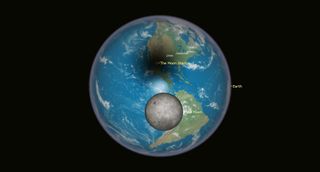
The new moon of Monday, April 8, 2024 will generate another Great American Total Solar Eclipse, following the previous one on August 21, 2017. This eclipse will occur along a 112 mile (180 km) wide track running across Mexico and eastern North America, giving lucky observers with sunny skies and eclipse glasses a chance to see the spectacle in the afternoon. Parts of San Antonio, Austin, Waco, Fort Worth, and all of Dallas will experience totality – the latter for 3m53s. From there the eclipse will cross parts of Oklahoma, Arkansas, Missouri, Kentucky, Indiana, and Ohio – giving Indianapolis and Cleveland a show at 19:06 GMT or 3:07 p.m. and 19:14 GMT or 3:14 p.m. EDT, respectively. The path will cover most of Lake Erie and Lake Ontario, providing totality to observers around Niagara Falls and Buffalo, NY. After Sherbrooke, Quebec sees 3m26s of totality, the moon’s shadow will cross northern Maine, then central New Brunswick and the western half of Prince Edward Island. The eclipse centre line will pass close to Channel-Port aux Basques at 5:09 p.m. Newfoundland Time and then sweep through central Newfoundland until it reaches the Atlantic Ocean at Bonavista, NFLD at 5:15 p.m. NT. The moon’s shadow will lift off the Earth in the North Atlantic Ocean at 19:53 GMT – a total trip time of 3h14m. A partial solar eclipse will be visible from Hawaii, across North America (except Alaska), Central America, and the northern edge of South America. Proper eclipse glasses will be required when any amount of the sun is visible, even for those on the total eclipse track. This eclipse will occur one day after perigee, generating large tides worldwide and also lengthening totality due to the increased size of the moon.
Wednesday, April 10 - Crescent Moon Joins Jupiter (after sunset)

A pretty sight will greet skywatchers at dusk on Wednesday, April 10 when the young crescent moon will pose to the upper left of the bright planet Jupiter in the western sky. The duo, which will share the view in binoculars (orange circle), will first appear as the sky begins to darken and then shine above the rooftops until about 9:30 p.m. local time – with the pretty Pleiades star cluster aka Messier 45 sprinkled a fist’s diameter above them. Earlier, watch for Earthshine on the moon. Sometimes called the Ashen Glow or the Old Moon in the New Moon’s Arms, the phenomenon is visible within a day or two of new moon, when sunlight reflected off Earth and back toward the moon slightly brightens the unlit portion of the moon’s Earth-facing hemisphere. Once the sky darkens, look for the small dot of Uranus above Jupiter and Comet 12P/Pons-Brooks less than a binoculars’ field below Jupiter.
Wednesday, April 10 - Mars Passes Saturn (before sunrise)
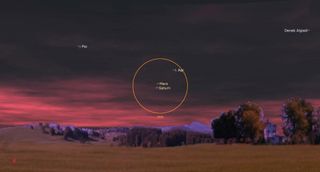
In the southeastern sky before sunrise on Wednesday, April 10, the easterly motion of reddish Mars will carry it closely past yellowish Saturn in a spectacular conjunction. The two planets, both about equally bright, will rise together around 5 a.m. local time and then climb until the morning twilight hides them. Mars and Saturn will be cozy enough to share the view in binoculars (orange circle) from April 3 to 18, and telescope-close from Tuesday to Friday – though they will swap sides over that period. Turn all optics away from the eastern horizon before the sun rises.
Thursday, April 11 - Moon with the Jewels of Taurus (evening)
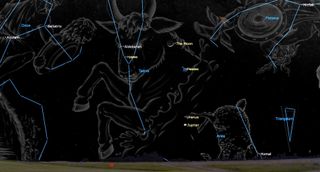
After posing near Jupiter the day before, on Thursday, April 11 the waxing crescent moon will hop higher in the western sky to shine above and between two jewels of Taurus in early evening. The bright little Pleiades star cluster, also known as the Seven Sisters and Messier 45, will be located to the moon’s lower right (or celestial west). The larger and sparser Hyades star cluster, which forms the triangular face of Taurus, the Bull, will twinkle off to the moon’s left. The bright planet Jupiter might catch your eye below them.
Friday, April 12 - The Winter Triangle (evening)

The lower part of the south and western sky on early April evenings is dominated by the three stars of the Winter Triangle. The prominent asterism, visible even while the waxing crescent moon is shining nearby on Friday, April 12, is anchored on the bottom by the magnitude -1.45 star Sirius or Alpha Canis Majoris, the brightest star in the night sky. Above Sirius (to the celestial NNE) shines the white, magnitude 0.34 star Procyon or Alpha Canis Minoris. The third, northwestern vertex is occupied by the reddish, magnitude 0.50 star Betelgeuse or Alpha Orionis. The Winter Triangle first appears in late evening during November. By the end of April it will be disappearing into the western post-sunset twilight.
Sunday, April 14 - Half Moon Hops Gemini’s Twins (evening)
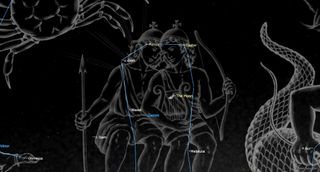
High in the western sky on Sunday evening, April 14, the almost half-illuminated, waxing gibbous moon will shine below Gemini’s brightest stars Pollux and Castor. As the night wears on, the moon’s eastward orbital motion will shift it closer to Pollux. All three will set around 2:45 a.m. local time. On the following evening, the first quarter moon will be positioned to the upper left (or celestial southeast) of those stars.
Monday, April 15 - First Quarter Moon (at 19:13 GMT)
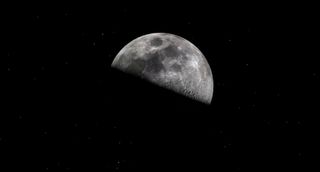
The moon will complete the first quarter of its orbit around Earth on Monday, April 15 at 3:13 p.m. EDT or 12:13 p.m. PDT and 19:13 GMT. At first quarter, the relative positions of the Earth, sun, and moon cause us to see our natural satellite half-illuminated - on its eastern side. First quarter moons always rises around noon and set around midnight, allowing them to be seen in the afternoon daytime sky, too. The evenings surrounding first quarter are the best for viewing the lunar terrain when it is dramatically lit by low-angled sunlight.
Tuesday, April 16 - Ptolemaeus, Alphonsus and Arzachel (all night)

On Tuesday night, April 16, the moon’s waxing gibbous phase will favor a look at a trio of large craters located a short distance south of the moon’s center (red lines). Ptolemaeus, Alphonsus, and Arzachel are all large enough to see with binoculars and any size of telescope. The northernmost crater Ptolemaeus (96 miles or 154 km wide) has been battered by later impacts that confirm its older age. The flat, almost featureless floor has been filled by lava flows, submerging its central peak and elevating its floor. Alphonsus (74 miles or 119 km wide) is older yet and only partially filled, allowing its central peak to remain visible. Alphonsus contains a triangle of dark spots that are most prominent when the moon is full - ash deposits from long-ago volcanic venting. Relatively young Arzachel (60 miles or 96 km wide) has an unaltered floor and a terraced rim. A large number of north-south lineations surround the craters - carved by ejecta blasted out during the powerful Imbrium Basin impact event.
Thursday, April 18 - Asteroid Juno Stands Still (all night)

On Thursday, April 18, the main belt asteroid designated (3) Juno will complete a westward retrograde loop that began in mid-January and return to regular eastward motion through the stars of Leo. Tonight, the bright waxing gibbous moon will be located a couple of finger widths above the faint magnitude 9.9 asteroid, so delay your viewing of Juno for a few nights to allow the moon to move away. Once the moon isn’t around, aim your binoculars (orange circle) a finger’s width above the medium-bright star Rho Leonis. As April continues into May, the asteroid will swing east and pass a medium-bright star named 53 Leonis.
Friday, April 19 - Enjoying Mare Imbrium (evening)

On Friday, April 19, the lunar terminator will have moved beyond the western rim of Mare Imbrium, the Sea of Rains. That dark, circular feature dominates the northwestern quadrant of the moon’s Earth-facing hemisphere. The mare is the moon’s largest impact basin, measuring more than 715 miles (1,145 km) in diameter. It was formed during the late heavy bombardment period approximately 3.94 billion years ago. Binoculars and backyard telescope views of Mare Imbrium at this phase will reveal ejecta blankets around its major craters Aristillus, Autolycus, and Archimedes, the nearly-submerged ghost craters Cassini and Wallace, the isolated mountain ranges Recti, Teneriffe, and Spitzbergen, and an interior ring of subtle wrinkle ridges. The half-circle of Sinus Iridum, the Bay of Rainbows, interrupts Imbrium’s western edge.
Saturday, April 20 - Jupiter Passes Uranus (after dusk)
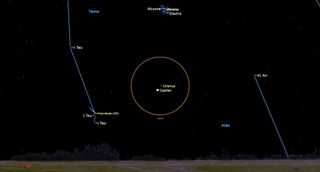
In the western evening sky on the evenings surrounding Saturday, April 20, the very bright planet Jupiter will have a close conjunction with the much fainter planet Uranus. You will need the sky to darken to see Uranus’ magnitude 5.8 blue-green spot in binoculars (orange circle). Before Saturday, Uranus will be positioned to Jupiter’s upper right (or celestial northeast). At closest approach on Saturday, the duo will easily share the eyepiece in a backyard telescope, with Uranus positioned half a finger’s width to the right (or 0.45 degrees to the celestial north) of Jupiter. Note that your telescope will likely flip and/or mirror their arrangement. After Saturday, Jupiter will climb higher than Uranus – but the pair will be settling into the western twilight. Watch for comet 12P/Pons-Brooks positioned to the lower left (or celestial south) of the two planets.
Sunday, April 21 - Lyrids Meteor Shower Peak (overnight)
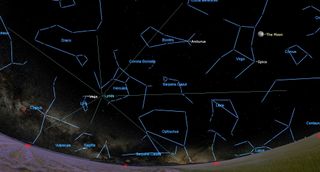
The annual Lyrids meteor shower, derived from particles dropped by comet C/1861 G1 (Thatcher), runs from April 16 to 29. It will peak in intensity at approximately 3 am EDT on Monday, April 22, but meteors should be seen while the shower’s radiant point near the bright star Vega in Lyra rises in the eastern sky late on Sunday night, April 21. The Lyrids can produce up to 15-20 meteors per hour at the peak, with occasional fireballs, but a full moon will spoil the shower this year. For best results, try to view the meteors from a safe location that has a wide open sky free of light pollution. Hide the bright moon behind a building or tree and just look up.
Monday, April 22 - Bright Moon Passes Spica (all night)
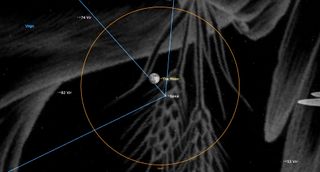
In the eastern sky commencing after dusk on Monday, April 22, the nearly full moon will be shining very close to Virgo’s brightest star Spica, which is 263 light-years away from our sun. Use binoculars (orange circle) to track the pair across the sky through the night. The moon’s orbital motion will shift it closely above and then farther to the left of Spica. Before dawn the moon will be positioned quite far to Spica’s upper left (celestial east-southeast).
Tuesday, April 23 - Full Pink Moon (at 23:49 GMT)
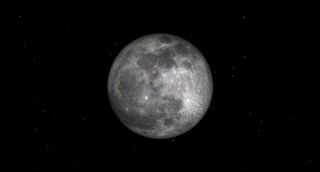
The moon will officially reach its full phase at 7:49 p.m. EDT or 4:49 p.m. PDT or 23:49 GMT on Tuesday, April 23. April’s full moon, commonly called the Pink Moon, Sprouting Grass Moon, Egg Moon, or Fish Moon, always shines in or near the stars of Virgo or Libra. The moon won’t look pink, though – the name arises from the forest wildflowers blooming in April. The indigenous Ojibwe groups of the Great Lakes region call the April full moon Iskigamizige-giizis “the Maple Sap Boiling Moon” or Namebine-giizis, “the Sucker Moon”. For them it signifies a time to learn cleansing and healing ways. The Cree of North America call it Niskipisim, “the Goose Moon” - the time when the geese return with spring. For the Mi’kmaw people of Eastern Canada, this is Penatmuiku’s, “the Birds Laying Eggs Time Moon”. The Cherokee call it Kawonuhi, “the Flower Moon”, when the plants bloom. Full moons always rise in the east as the sun sets, and set in the west at sunrise.
Thursday, April 25 - Gibbous Moon Approaches Antares (late night)

Once the bright, waning gibbous moon clears the treetops in the east around midnight local time on Thursday, April 25, it will be shining among the little white claw stars of Scorpius and almost a fist’s diameter to the upper right (or celestial west-northwest) of the very bright reddish star Antares, which marks the scorpion’s heart. By dawn on Friday, April 26 in the Americas, the moon will have crept a bit closer to Antares. Almost a day later, skywatchers from northeastern Africa and parts of the Middle East and across the Indian Ocean to Indonesia can see the orbital motion of the moon (green line) carry it in front of Antares in the wee hours of April 27.
Friday, April 26 - The Three Leaps of the Gazelle (all night)
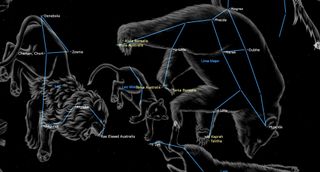
The large and bright constellation of Ursa Major, the Great Bear is at the zenith after dusk in late April. Everyone is familiar with the Big Dipper asterism portion of that constellation. Another easily seen, but lesser-known pattern is the Three Leaps of the Gazelle, composed of three pairs of medium-bright stars strung in a line spanning nearly 30 degrees of the sky. In each pair, the stars are separated by about a thumb’s width (or 1.5 degrees). The most westerly stars Al Kaprah and Talitha, are found by extending a line drawn diagonally through the Big Dipper’s bowl from Megrez to Merak, i.e., towards Castor and Pollux. The central pair of Tania Borealis and Tania Australis shines midway between the bright stars Dubhe and Ras Elased Australis in Leo. The lowest (most easterly) duo named Alula Borealis and Alula Australis, are close to a line extended to the right (celestial south) from Dubhe through Merak. The word Alula arises from Arabic for “first leap”, while Tania means “second”, and Talitha means “third”.
Monday, April 29 - Mars Meets Neptune (pre-dawn)
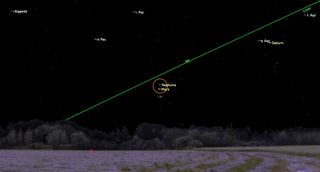
In late April, the two bright planets Mars and Saturn will shine above the eastern horizon every morning before sunrise. Monday morning, April 8 offers an opportunity to see the distant and faint planet Neptune when it will be positioned just to the upper right (or celestial west) of Mars. Blue Neptune and reddish Mars will share the view in a backyard telescope (orange circle) from Saturday to Tuesday. At closest approach on Monday, Neptune will appear just 0.2 degrees from Mars. Skywatchers living at lower latitudes, where the ecliptic (green line) will be more vertical, will see the planets more easily – higher and in a darker sky.
Visible planets in February
Mercury
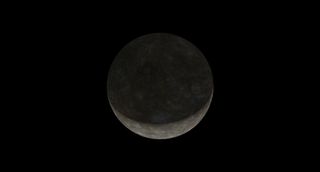
For the first several days of April, Mercury might be glimpsed briefly just above the western horizon after sunset. It will drop lower each day, pass the sun at inferior conjunction on April 11, and then enter the eastern pre-dawn sky. The speedy planet will become visible above the eastern horizon before sunrise towards the end of April, when it will attain a magnitude of 1.1 and show a waxing crescent and a 9.75 arc-seconds-wide disk in telescopes. That April-May morning apparition of Mercury will be so-so for mid-northern latitude observers, but a good one for those in the tropics and farther south. Southerly observers will also have the advantage in seeing Mercury when it sits a thumb’s width above (or celestial north of) far brighter Venus on April 19.
Venus

Brilliant, magnitude -3.8 Venus will have effectively ended its lengthy morning showing when April begins, but the planet will remain tucked just above the eastern horizon before sunrise every morning while it reduces its angle from the sun. Observers at southerly latitudes will see Venus more easily. Viewed in telescopes from there, the planet will exhibit a nearly fully illuminated disk spanning about 10 arc-seconds. The very slim crescent of the old moon will be positioned several degrees to the right (or celestial southwest) of Venus on April 7.
Mars
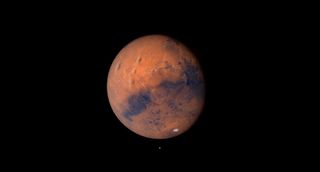
Mars will spend April in the southeastern pre-dawn sky, slowly increasing its angle from the morning sun from 35 degrees to 40 degrees. Mars’ eastward orbital motion through Aquarius and then Pisces will allow it to overtake slower Saturn on the mornings surrounding April 10. The two equally bright planets, one red, one yellow, will share the view in a backyard telescope for several days. The old crescent moon will form a triangle below Saturn and Mars on April 6. During April Mars will brighten slightly, from magnitude to 1.18 to 1.12. The red planet will have a very close conjunction with Neptune on April 29, but the far fainter blue planet will be a challenge to see. At the end of April, Mars will be rising with the stars around 4:20 a.m. local time. Its position on the far side of the sun from Earth all month will give the planet a rather small 4.75 arc-seconds-wide disk in telescopes.
Jupiter
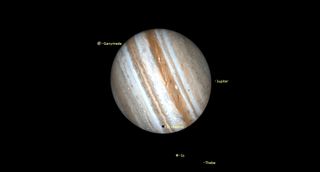
During April, brilliant Jupiter will end its dominance of the western evening sky as it is carried lower and sunward every day. The brilliant, magnitude -2.0 planet will remain observable in telescopes among the stars of Aries for the first week or so, and then it will be better enjoyed in binoculars until it becomes completely swallowed by the post-sunset twilight. The pretty, waxing crescent moon will pose to Jupiter’s upper right (or celestial north) on April 10. Comet 12P/Pons-Brooks will pass 3 degrees below Jupiter on the nights surrounding April 13. Faster-moving Jupiter has been approaching far fainter Uranus for some time. On April 1, Uranus will be positioned 3.3 degrees above (or celestial east of) Jupiter. The two planets will have a close conjunction, only 0.5 degrees apart, on April 20.
Saturn
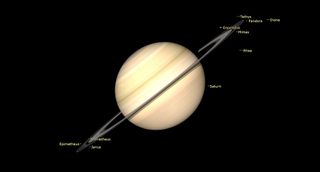
Saturn will spend April in the eastern morning sky, shining near Mars and increasing its angle from the pre-dawn sun. The slanted ecliptic at mid-northern latitudes will hold it low in the sky – and prevent us from seeing the stars of Aquarius around the magnitude 1.1 ringed planet - until about mid-month. Saturn and Mars will appear equally as bright all month long, though a contrast in color. Mars will shine to Saturn’s upper right (or celestial west) in early April, pass telescope-close to Saturn on the mornings surrounding April 10, and then draw farther east of Saturn for the rest of the month. Observers in the tropics will see the two planets more easily. The waning crescent moon will shine below them on April 6. In a telescope Saturn will sport a globe spanning about 16 arc-seconds. Its rings which will become edge-on to Earth in March, 2025, will already be extremely narrow. Our edge-on views to the Saturn system this year and next will produce transits of Saturn’s moons across its disk.
Uranus

Like nearby Jupiter, Uranus will only be observable in the western sky after dusk during early April; but its daily descent sunward will limit our telescope time on it. The blue-green, magnitude 5.8 planet will be creeping eastward through the stars of southeastern Aries, with 1,400 times brighter Jupiter positioned below it. Jupiter will approach Uranus until they pass only 0.5 degrees apart, and low in the west-northwestern sky, on April 20. On April 10 the waxing crescent moon will shine to the upper right of Uranus and Jupiter.
Neptune

After passing the sun at solar conjunction in mid-March, late April will see the distant planet Neptune gradually attain visibility low in the eastern pre-dawn sky among the stars of western Pisces. Magnitude 1.12 Mars will pass extremely close to magnitude 7.95 Neptune on April 29, but the far fainter blue planet will be a challenge to see.
Skywatching terms
Gibbous: Used to describe a planet or moon that is more than 50% illuminated.
Asterism: A noteworthy or striking pattern of stars within a larger constellation.
Degrees (measuring the sky): The sky is 360 degrees all the way around, which means roughly 180 degrees from horizon to horizon. It's easy to measure distances between objects: Your fist on an outstretched arm covers about 10 degrees of sky, while a finger covers about one degree.
Visual Magnitude: This is the astronomer's scale for measuring the brightness of objects in the sky. The dimmest object visible in the night sky under perfectly dark conditions is about magnitude 6.5. Brighter stars are magnitude 2 or 1. The brightest objects get negative numbers. Venus can be as bright as magnitude minus 4.9. The full moon is minus 12.7 and the sun is minus 26.8.
Terminator: The boundary on the moon between sunlight and shadow.
Zenith: The point in the sky directly overhead.
Night sky observing tips
Adjust to the dark: If you wish to observe fainter objects, such as meteors, dim stars, nebulas, and galaxies, give your eyes at least 15 minutes to adjust to the darkness. Avoid looking at your phone's bright screen by keeping it tucked away. If you must use it, set the brightness to minimum — or cover it with clingy red film.
Light Pollution: Even from a big city, one can see the moon, a handful of bright stars, and the brightest planets - if they are above the horizon. But to fully enjoy the heavens — especially a meteor shower, the fainter constellations, or to see the amazing swath across the sky that is the disk of our home galaxy, the Milky Way — rural areas are best for night sky viewing. If you're stuck in a city or suburban area, use a tree or dark building to block ambient light (or moonlight) and help reveal fainter sky objects. If you're in the suburbs, simply turning off outdoor lights can help.
Prepare for skywatching: If you plan to be outside for more than a few minutes, and it's not a warm summer evening, dress more warmly than you think is necessary. An hour of winter observing can chill you to the bone. For meteor showers, a blanket or lounge chair will prove to be much more comfortable than standing, or sitting in a chair and craning your neck to see overhead.
Daytime skywatching: On the days surrounding first quarter, the moon is visible in the afternoon daytime sky. At last quarter, the moon rises before sunrise and lingers into the morning daytime sky. When Venus is at a significant angle away from the sun it can often be spotted during the day as a brilliant point of light - but you'll need to consult an astronomy app to know when and where to look for it. When large sunspots develop on the sun, they can be seen without a telescope — as long as you use proper solar filters, such as eclipse glasses. Permanent eye damage can occur if you look at the sun for any length of time without protective eyewear.
Join our Space Forums to keep talking space on the latest missions, night sky and more! And if you have a news tip, correction or comment, let us know at: community@space.com.
Get the Space.com Newsletter
Breaking space news, the latest updates on rocket launches, skywatching events and more!
Chris Vaughan, aka @astrogeoguy, is an award-winning astronomer and Earth scientist with Astrogeo.ca, based near Toronto, Canada. He is a member of the Royal Astronomical Society of Canada and hosts their Insider's Guide to the Galaxy webcasts on YouTube. An avid visual astronomer, Chris operates the historic 74˝ telescope at the David Dunlap Observatory. He frequently organizes local star parties and solar astronomy sessions, and regularly delivers presentations about astronomy and Earth and planetary science, to students and the public in his Digital Starlab portable planetarium. His weekly Astronomy Skylights blog at www.AstroGeo.ca is enjoyed by readers worldwide. He is a regular contributor to SkyNews magazine, writes the monthly Night Sky Calendar for Space.com in cooperation with Simulation Curriculum, the creators of Starry Night and SkySafari, and content for several popular astronomy apps. His book "110 Things to See with a Telescope", was released in 2021.
-
Malcolm Hi MMohammad,Reply
Thank you for your gracious welcome via email, though I fear we are ‘light years’ away from each other (as my comment shows, if it stays and is not censored) when it comes to this Earth and the Universe in which we live. I am no expert but each to their own beliefs.
Regards,
Malcolm -
Skyguy712 Reply
so much cap like if they don't exist then it's all most impossible for the universe to exist, i have a theory of the big bang, the white hole theory, i believe that a black hole had held gas and dust for millions of years and then it got older and older that it had died and spit up the dust and matter and gas and such, then it all collided making planets and suchcorey555 said:Black holes don't exist

